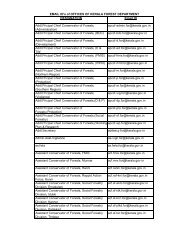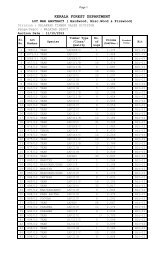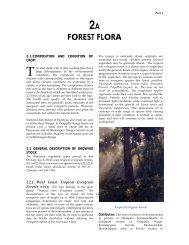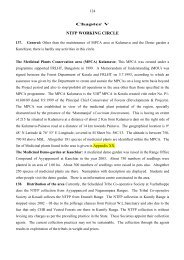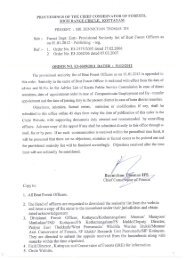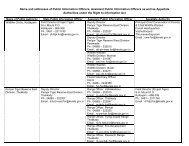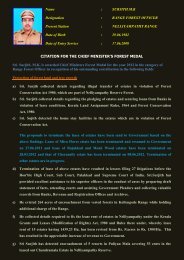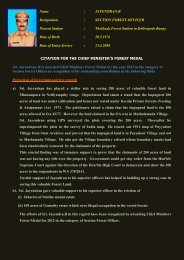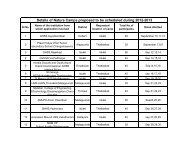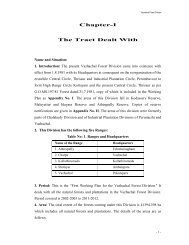Create successful ePaper yourself
Turn your PDF publications into a flip-book with our unique Google optimized e-Paper software.
ACKNOLEDGEMENTSThe assistance rendered by Sri N. S. Sathyaseelan, M.S. Sujeendranath, and U. Baby, Foresters in thecollection of field data for the working plan is gratefully acknowledged.Sri. P. Dhanesh Kumar, T.R Haridas, K. Mohandas, and V. R. Asok kumar, Range officers, werekeen in steering data collection and also in the compilation of the same for the preliminary draft.Their assistance to my predecessor is duly acknowledged.Thanks are due to Sri. B. P. Varghese, Deputy Conservator of Forests, my predecessor, for bringingout the draft of the plan during November 2004, upon which, the present working plan in theNational Working Plan Code format is built.I am very grateful to my assistants in the final stage of preparation of the Plan, Sri. Purushothaman,and Jayaprakash, Foresters, and also Sri. Vincent. M. Arackal, Range officer. Most of the growingstock enumeration, Socio- Economic surveys and collection of data from various supplementarysources have been successfully done by the above team.I am thankful to Smt. M. P. Kshamadevi, UDC, for the clerical support and also to Sri. Mohandas,compiler. Sri. Anup. K. Balakrishnan , computerized the entire plan.The Maps produced in this working plan have been developed by the Geo Informatics Center at theforest head quarters. The efforts of Sri. S. Sreekumaran Nair of the GI center is duly acknowledged.I have had suggestions of how to improve the plan, from various sources who had seen earlierversions. In particular, Mr. B. N. Jha, Chief Conservator of Forests, (Central) during mypresentation of the draft plan on 29.9.05 at the forest head quarters, Thiruvananthapuram,suggested pages and pages of comments and queries about points he felt I had not explainedproperly. I must admit that he was quite right, and I am indebted to him. I am sure that, it is abetter working plan as a result of his keeping my nose to the grindstone.
GLOSSARY OF TERMSArchaean RocksAbundanceAlluvial soilAmphibiansBasic dykesBiotiteBreast heightCommercial volumeCurrent Annual IncrementDensityDominant treesDiseased treesErosionEcologyFelsparFrequencyForest managementForest soilBroadly, rocks of Pre- Cambrian age, the term is sometimes restricted tothe older, crystalline part of the pre - CambrianThe number of individuals of any species per sampling units ofoccurrence.Sol, formed by deposits, which have been carried in suspension byRiver/ flood and laid down where, the speed of flow has come to acheck. They are very much productive.Transitional between aquatic and terrestrial life. Have gills in youngand lungs in adults. Limbs are fingered and toed. Exoskeleton absent.A sheet of igneous rock formed by crystallization of magma that hasforced its way up through a cleft inclined at a high angle to the layers ofpre existing rocks.A black mica of variable composition, consisting of silicates, withPotassium and hydroxyls. Widely distributed, original constituents ofigneous rocks.Standard height for measuring girth, diameter etc. of standing trees. InIndia and in other former British colonies it is taken as 1.37 m aboveground level. On slopes, BH is taken on uphill side.A measure of volume of trees, which consists of the volume of thecommercial bole plus volume measured to a thin end diameter.Strictly, the increment in a specific year. Usually taken as the periodicannual increment over a short preceding period.Numerical strength of a species in the community. The number ofindividuals of a species in any unit area is its density.All trees which form the uppermost leaf canopy.Trees, which are infected with Parasites, to such an extent that, theirgrowth is seriously affected, or they are a danger to their neighbours.The lowering of the land surface by weathering, corrosion, andtransportation under the influence of gravity, wind, and running water.Study of organism in relation to its surroundings.A very important group of rock forming minerals, essentially silicates ofAluminium, Potassium, Sodium, Calcium, and Barium.The number of sampling units in percent in which a particular speciesoccurs.It is the practical application of the scientific technical and economicprinciples of forestry.Soil having the deposition of organic matter derived from the forests.
GneissGrowing stockHabitatHumidityIgneous rocksIncrementLoamy soilMammalsMean Annual IncrementQuartzReserved forestsReptilesRotationSite qualitySustained yieldWorking circleWatershedYield regulationA foliated crystalline rock, generally Felspatic and of Graniticcomposition. Individual folia are discontinuous.The sum by number or Volume of all the trees growing in the forest oron a specified part of it.In common parlance, it connotes to the place in which an organismlives.The invisible water vapour present in the air. This is the amount aspercentage of the maximum quantity that the air can hold at aprevailing temperature.All rocks of magnetic and plutonic origin, such as lava dykes, sills, andintrusions.The rate at which, a tree or a crop increases with age. The term is oftenapplied to the increase in girth, diameter, basal area, height, volume,quality, price or value of individual trees or crops during a givenperiod.A detrital material deposit consisting of nearly equal proportions ofparticles of sand, silt and clay grades.Highly evolved animals, derived from their reptilian ancestors between250-150 million years ago.The total increment upto a given age divided by that age.An important mineral; SiO2, Resistant o acids, slightly soluble in alkalisAn area, legally notified as Reserved Forests under the statute.Characterized by scaly skin. Have two foetal membranes. Have no gills,and cold blooded.The time chosen for any proposed cycle of operation. Often applied tothe planned number of years between the formation or regeneration of acrop and its final felling.A measure of the relative productive capacity of a site for a particularspecies. The Top height is generally taken as the basis for classification.Continuous production with the aim of achieving in the earliest possibletime the highest practical level or approximate balance between netgrowth and harvest by annual or somewhat longer period.An area subjected to one and the same cultural treatment by means of adistinct series of operations. Where, the condition and composition ofthe crop render it advisable, a working circle for which, a definitemethod of treatment is prescribed may overlap portions or the whole ofother working circles .A region or area, bounded peripherally by a waterparting and drainingultimately to a particular watercourse or body of water.It is the calculation of the amount of material that can be removedconsistent with the prescribed treatment and how and from where inthe forest that quantity is to be removed.
ABBREVIATIONSArCACAICMACPICRZDADFEICDFOF&WLDFCAFDAFITFMISGBHGI SGOGOKGOIHRDIRMKFDJFMKFPKFRIMAIMSLMoEFNGONWFPNRFPCCFPCKPRAPFMPFMSQCRDFRFPFROSSPSPASTPVSSWGDPAar (River)Compensatory AfforestationCurrent Annual IncrementClonal Multiplication Area.Consumer Price IndexCoastal Regulation Zone.Daily AllowanceDistrict Forest Extension and Information Centre.Divisional Forest OfficerForest & Wildlife DepartmentForest Conservation Act.Forest Development AgencyForest Industries Travancore ltd.Forest Management Information SystemGirth at Breast HeightGeographic Information SystemGovernment OrderGovernment of KeralaGovernment of IndiaHuman Resource DevelopmentIndustrial Raw MaterialsKerala Forest DepartmentJoint Forest ManagementKerala Forestry ProjectKerala Forest Research Institute.Mean Annual IncrementMean Sea LevelMinistry of Environment & ForestsNon Governmental Organization.Non Wood Forest Produce.Non Revertible ForestPrincipal Chief Conservator of ForestsPlantation Corporation of KeralaParticipatory Rural AppraisalParticipatory Forest ManagementParticipatory Forest Management SystemQuality ClassRehabilitation/ Restoration of Degraded ForestsRiver Forest Protection FundRange OfficerSite Specific PlanSeed Production AreaStores, Tools and PlantsVana Samrakshana SamithyWestern Ghat Development Programme
LIST OF COMMON ANIMALS AND BIRDSIN CHALAKUDY DIVISIONLOCAL NAME ENGLISH NAME SCIETIFIC NAMEMAMMALSKaduva Tiger Panthera tigrisAana Elephant Elephas maximusPuli Leopard Panthera pardusKaradi Sloth bear Melursus ursinusKattupothu Indian Bison Bos gaurusChennai Indian wild dog Cuon alpinusisVellakurangu Bonnet Macaque Macaca radiataSinhavalan Kurangu Lion Tailed Macaque Macaca silensusKarimkurangu Nilgiri langur Presbytis johniKalaman Barking deer Muntjacus muntjakPulliman Spotted deer (Chital) Axis axisMlavu Sambar Cervus unicolorKooran Mouse deer Trangulus meminnaVallippuli Leopard cat Felis bengalensisKattumakkan Jungle cat Felis chausKurukkan Jackal Canis aureusVeruku Malabar civet Viverra megaspilaMarappatty Palm civet Paradoxus hermaphroditusKeeri (Grey) Common mongoose Herpestes edwardsiKeeri ( Brown ) Stripped necked mongoose Herpestes vitticollsKattupanni Indian wild Boar Sus scrofaMullan panni Indian porcupine Hystrix indicaAlunku Pangolin Manis pentadactylaMulleli Hedgehogs PeraechinusAnnan Palm squirrel Funambulus palmarumKuttithevangu Slender Loris Loris tardigradusParan Flying squirrel Petaurista patauristaMalayannan Malabar squirrel Ratufa indicaVaval Bats ChiropteraNaricheer Pipistrelle Vaspeugo abramusREPTILESAama Tortoise Testudo travancoricaOnthu Common Garden Lizard Calotes versicolorUdumbu Monitor Lizard VaranusMaraOnthu Chamaeleon Chamaeleon zeylanicusDraco or Flying Lizard Draco dussumieriArana Common Indian Monitor Manis crassicanPerumpampu Indian Python Python molurusChera Common Rat Snake Pytas mucosusPachilapampu Common Green Whip Ahaetulla nasutusSnakeEttadiveeran/ Common Indian Krait Bungarus candidusSankuvarayanMoorkhan Indian Cobra Naja najaRaja vempala King Cobra Ophiophagus hannahAnali Russel’s Viper Vipera russelli
NeerkoliBIRDSNerodia piscatorKattukozhy Grey jungle fowl Gallus sonneratil.Kada Quails Perdicula asiaticaMala-Muzhaki Great Indian hornbill, Buceros bicornisVezhambalKozhi vezhambal Malabar Grey HornbillPandan Vezhambal Malabar Pied HornbillKariyila-Pakshi Babblers Turdoides striatusMannathikeechi, Magpie Robin Copsychus malabaricusNattubulbul Red vented Bulbul Pycnonotus caferNakamohan paradise fly catcher Tehitrea paradisiTailor birdsOrthotomus sutoriusManjakilyMynaIndian Oriolecommon MynaOriolus oriolusAcrido-theresKuttumyna The southern Grackle Gracula religiosa,Malabar whistling thrush Myiophoneus,The Nilgiri thrushOreocinclaAttukuruvi Weaver bird Ploceus philipinusMaramkothi Wood-peckers Brachy-pternusUppan Crow- Pheasant CentropusThe Brainfever Bird HierococcyxKuil Koel Eudynamis scolopaceaAripravu Indian Spotted Dove steptopelia chinensisPonman White breasted kingfisher Halcyon smyrnensisKrishna Parunthu Brahminy kite Haliaster indicus,Chempan Nathu Jungle owlet Glaucidium radiatumOoman Fish owl Bubo zeylonensisKattu Moonga Eagle owlKulakkozhi Water hen Amaurornis
CONTENTSPART - ISUMMARY OF FACTS ON WHICH PROPOSALS ARE BASEDCHAPTER-IThe Tract Dealt withPagesName and SituationConfiguration of the GroundGeologyClimate 1-13Major Water sourcesMajor Watersheds and their distributionDistribution of the areaState of BoundaryLegal PositionRights and concessionsCHAPTER II A.The FloraComposition and Condition of the CropGeneral description of Growing stockBamboo, Rattans, Reeds and Sandal 14-23Status of Natural RegenerationEco- systems outside Reserved ForestsInjuries to which crop is liableCHAPTER II B.FaunaGeneral distributionProximity to Protected areasDescription of fauna 24-30Injuries to which Fauna is liableList of Animals & BirdsCHAPTER-IIIUtilization of ProduceAgricultural Customs and wants of PeopleMarkets and Marketable ProduceDemand/ Supply of forest produce and Pressure on Forests 31-36Method of HarvestLines of exportPast and Current Prices
CHAPTER-IVDependence of local people on forestsGeneralPopulationCattle populationOccupation and Annual income 37-42Sources of Energy and FodderSocial customs and traditional knowledgeForest user groups as Resource ManagersCHAPTER- VFive Year PlansNo Five Year plans existed in the past to manage the Forests,Natural or other43CHAPTER- VIStaff and Labour supplyStaff strengthLabour 44-46Tribal LabourWage ratesCHAPTER-VIIPast system of ManagementIntroductionGeneral History of ForestsPast system of Management and ResultsPrevious Working plansDiversion of Forests for non forestry purposesSpecial works of improvements taken up 47-64Central Nursery, ChettikulamActivities in Central NurseryPlanting stock in Central NurseryKFRI Field Research centre, VelupadamActivities by Silvicultural Research WingActivities by SF wingPast Yield, Revenue and ExpenditureCHAPTER VIIIStatistics of GrowthQuality Class Mapping in Teak & SW plantationsGrowing stock in PlantationsGrowing stock in Natural forests 65-66Regeneration survey in Natural forestsCapital value of ForestsValuation of Forests- Different perceptions
PART IIFUTURE MANAGEMENT DISCUSSED AND PRESCRIBEDChapter-IBasis of ProposalsIntroductionObjects of ManagementManagement strategy 67-69Working circles and their constitutionCHAPTER IIEco-restoration and Protection Working CircleThe State of ForestsObjects of ManagementProtection of existing forestsEco Restoration of degraded forests 70-77General treatments for Eco RestorationStrengthening Protection and Improving amenities to staffUpgradation of professional& Technical skill of staffCHAPTER-IIIPlantation Working CircleObjectives of ManagementTeakRegeneration in final felling areasQuality of Planting stockPests and DiseasesThinningSoftwood Plantations 78-97Pulpwood PlantationsBamboo PlantationsCashew PlantationsMiscellaneous/ Mixed PlantationsUnder plantingsGeneral prescription for plantationsCHAPTER-IVBamboo, Reed & Rattan Working CircleObjectivesBamboo 98-109ReedsRattans
CHAPTER- VParticipatory Forest Management Working CircleIntroductionConstitution of working circleObjectives of ManagementVSS in Chalakudy Division 110-116Tribal VSSFDAPrescriptionsCHAPTER-VIBiodiversity and Wildlife working CircleIntroductionObjectivesManagement imperatives 117-120PrescriptionsThe Kole wetlandsCHAPTER-VIIMiscellaneous RegulationsRevision of Reserve notificationSurvey & Demarcation of plantations & Fringe areasExtraction of trees in assigned landsDis- Reservation of NRF landsControl formsCollection of wind fallen timber from ReservesApplication of FMIS 121-127Centrally sponsored schemesQuarriesProtection of Sandal areasTree planting in Non Forest landsConservation of Eco systems outside Reserve ForestsAppendices 128 - 215References 216-217Summary of Prescriptions 218-230
LIST OF APPENDICESPage 128 to 215IBoundary description of DivisionIIForest stations boundaryIIIChief peaks in the DivisionIIIAList of Assets in the divisionIVWeather dataVRange wise details of Cairns and Jungle stone walls constructed in ChalakudyDivisionVIList of Ecologically fragile areas vestedVIIDetails of Joint verification of EncroachmentsVIIIList of Tribal colonies in the DivisionIXList of plantations in the DivisionXDetails of fire occurrenceXIRange wise details of forest offences for the last 10 yearsXIIClassification of TimberXIIIPrice statement for the major forest produceXIVStatement showing sanctioned and existing strength of staff under variouscategories, in the Division.XVList of Officers in charge of Chalakudy DivisionXVIStatement showing fixation of Basic wages for different categories of workers indifferent categories of areas.XVIIDetails of plantations final felled and thinned during the working plan period ofSri.L. Kurian Akkara.XVIII List of Plantations prescribed for final felling and thinning and the plantationsactually worked during the Management plan periodXIXNew Plantations raised during the Management plan period.XXList of Forest areas Leased outXXI Areas diverted for Non- Forestry purposes before FC Act, 1980XXII Areas diverted for Non- Forestry purposes after FC Act, 1980XXIII Year wise activities under Kerala Forestry Project with expenditureXXIV Details of areas handed over to Social Forestry wing for treatmentXXVQuality class mapping- TeakXXVI Quality class mapping- Soft wood plantationsXXVII Projected growing stock of plantations in the DivisionXXVIII Abstract of Growing stockXXIX Projected growing stock of Natural forests in the DivisionXXXDetails of Regeneration surveyXXXI Estimated value of tree growth in Natural forests in the DivisionXXXII Estimated value of tree growth in Plantations in the DivisionXXXIII Abstract of Estimated Value of Growing stock in Natural forests andPlantations.XXXIV Capital Value of Forests in Chalakudy DivisionXXXV Chief Conservator of Forests letter on the thinning regime in Teak plantationXXXVI General direction for the management of NWFP and constitution of Tribal VSSXXXVII Guidelines for harvesting of trees raised by Social Forestry wing
LIST OF TABLES1 Administrative Units and Sub Units2 Micro Watersheds of Chalakudy and Karuvannur Watersheds, falling inChalakudy division3 Range wise distribution of the area4 Notified Reserves in the Division5 Mangrove areas in Chalakudy Division6 Infestation level of pest Alcterogystia cadambae – Chalakudy Division7 Taluk wise Population, Decadal growth and Literacy rate8 Taluk wise details of Villages9 Cattle Intensity10 Household details and daily consumption of firewood from forests11 List of VSS12 Staff strength – Office wise13 Basic wages based on G.O (Ms) 49/9914 Seedling production – Central Nursery15 Central Nursery: Year of establishment of Clones16 List of Clonal multiplication areas17 Yield from Teak plantations18 Revenue collection- Last ten years19 Budgetary allocation last 10 years20 Expenditure – Last ten years21 Percentage of Expenditure22 Distribution of Plantations23 Teak yield and MAI for different ages and site quality classes24 Distribution of final yield for different rotation age25 List of over matured Teak plantations26 List of Teak plantations attain rotation age during the plan period27 Yield obtained from final felled plantations28 Final felling schedule29 Thinning cycle for Teak Plantations30 Number of trees/ ha to be retained at each Thinning31 Schedule of Thinning32 List of Softwood Plantations in Chalakudy Division33 Growing stock of Teak –Elavu plantations in Chalakudy Division34 Schedule of treatments for the Teak –Elavu Plantations35 Growing stock of Elavu plantations in Chalakudy Division36 List of Pulpwood Plantations37 Schedule of harvest and Regeneration of Pulpwood Plantations38 Bamboo Plantations in Chalakudy division39 Cashew plantations in Chalakudy division40 Miscellaneous Plantations and mixed plantations
LIST OF TABLESContd…..41 List of plantations under planted with other species in Teak & Teak –Elavuplantations42 Assessment of Bamboo growing stock43 Flowering and fruiting period of Calamus species in Western Ghats44 VSS in Chalakudy division45 Proposed routes for adventure trekking46 Commercial information on some of the common homestead Medicinal plantsspecies47 Red data book species sighted in Kole wetlands



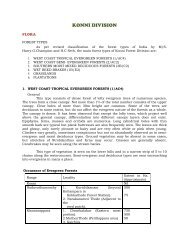
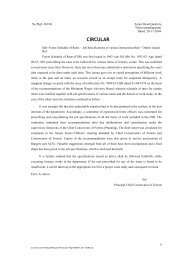
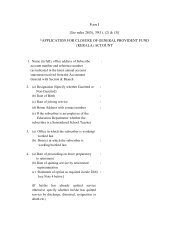
![[See rules 14 & 37(1)] FORM OF APPLICATION FOR TEMPORARY ...](https://img.yumpu.com/49611345/1/190x245/see-rules-14-371-form-of-application-for-temporary-.jpg?quality=85)
